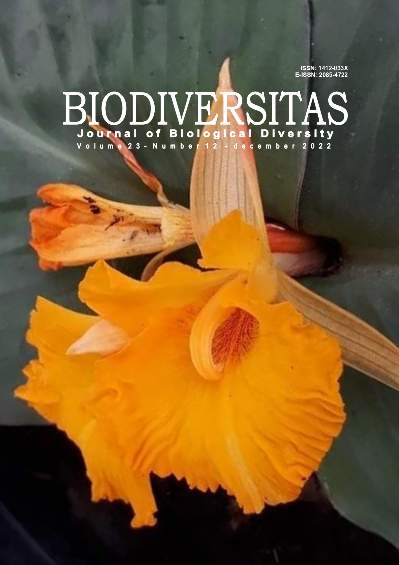Isolation and identification of fungi associated with Falcataria moluccana gall-rust in Kediri, East Java, Indonesia
##plugins.themes.bootstrap3.article.main##
Abstract
Abstract. Istikorini Y, Cahyani NN, Haneda NF, Shabrina H, Nugroho A, Indriani F, Siregar UJ. 2022. Isolation and identification of fungi associated with Falcataria moluccana gall-rust in Kediri, East Java, Indonesia. Biodiversitas 23: 6171-6179. Gall-rust disease caused by Uromycladium falcatariae is the most important disease of sengon in Indonesia. Plant pathogenic parasitism as a biological control mechanism is usually associated with fungal biocontrol agents. This study aimed to isolate and identify the fungi associated with the sengon gall rust from the Forest Management Unit of Jatirejo, Indonesian State Forest Company, Kediri. Fungi were isolated from the black or gray-green patches of gall-rust samples on Potato Dextrose Agar (PDA) plates. The fungi were identified using macroscopic and microscopic examinations. The molecular identification of fungal DNA was amplified by PCR using a specific internal transcribed spacer primer (ITS1/ITS4). The PCR products were sequenced and compared with the other related sequences in GenBank (NCBI). DNA barcode identification results showed 9 isolates containing of 8 species, namely Fusarium oxysporum, F. solani, F. chlamydosporum, F. circinatum, F. incarnatum, F. verticillioides, Lasiodiplodia theobromae, and Pestalotiopsis palmarum. This result showed that the Fusarium was the most fungi commonly found fungi on the gall's rust teliospore surface.
##plugins.themes.bootstrap3.article.details##
Most read articles by the same author(s)
- NOOR FARIKHAH HANEDA, IWAN HILWAN, EWI IRFANI, Arthropod community at different altitudes in Gunung Halimun-Salak National Park, Western Java, Indonesia , Biodiversitas Journal of Biological Diversity: Vol. 20 No. 6 (2019)
- ULFAH J. SIREGAR, DEWI RAHMAWATI, APRILIYA DAMAYANTI, Fingerprinting sengon (Falcatria moluccana) accessions resistant to boktor pest and gall rust disease using microsatellite markers , Biodiversitas Journal of Biological Diversity: Vol. 20 No. 9 (2019)

